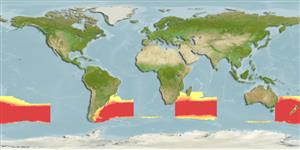>
Aulopiformes (Grinners) >
Paralepididae (Barracudinas)
Etymology: Magnisudis: Latin, magnus = large + Latin, sudis = esox, fish of the Rhine, cited by Plinius 9.15; it also means "stake" (Ref. 45335).
Environment: milieu / climate zone / depth range / distribution range
Ökologie
seewasser bathypelagisch; tiefenbereich 0 - 1000 m (Ref. 4056), usually 300 - 800 m. Deep-water; 20°S - 60°S
Probably circumglobal in the Southern Ocean from about 20°S to Antarctica. Specimens south of the Antarctic Convergence probably expatriated.
Size / Gewicht / Alter
Maturity: Lm ? range ? - ? cm
Max length : 55.0 cm TL Männchen/unbestimmt; (Ref. 4056)
Rückenflossenstacheln (insgesamt) : 0; Rückenflossenweichstrahlen (insgesamt) : 9 - 11; Afterflossenstacheln: 0; Afterflossenweichstrahlen: 22 - 25. Body pale with brownish dorsal band (Ref. 4056).
Vertically, juveniles occur from near surface to about 200 m and adults down to 1,000 m but mainly between 300-800 m. Feeds mainly on fishes.
Life cycle and mating behavior
Maturities | Fortpflanzung | Spawnings | Egg(s) | Fecundities | Larven
Post, A., 1990. Paralepididae. p. 138-141. In O. Gon and P.C. Heemstra (eds.) Fishes of the Southern Ocean. J.L.B. Smith Institute of Ichthyology, Grahamstown, South Africa. (Ref. 5176)
IUCN Rote Liste Status (Ref. 130435)
Bedrohung für Menschen
Harmless
Nutzung durch Menschen
Fischereien: kommerziell
Tools
Zusatzinformationen
Download XML
Internet Quellen
Estimates based on models
Preferred temperature (Ref.
123201): 2.7 - 9.9, mean 6.8 °C (based on 393 cells).
Phylogenetic diversity index (Ref.
82804): PD
50 = 0.6250 [Uniqueness, from 0.5 = low to 2.0 = high].
Bayesian length-weight: a=0.00224 (0.00090 - 0.00555), b=3.14 (2.92 - 3.36), in cm total length, based on LWR estimates for this (Sub)family-body shape (Ref.
93245).
Trophic level (Ref.
69278): 4.5 ±0.80 se; based on food items.
Fishing Vulnerability (Ref.
59153): Moderate vulnerability (42 of 100).
Nutrients (Ref.
124155): Calcium = 22 [7, 65] mg/100g; Iron = 0.296 [0.100, 0.908] mg/100g; Protein = 16 [13, 18] %; Omega3 = 0.101 [0.026, 0.320] g/100g; Selenium = 16.7 [5.4, 47.8] μg/100g; VitaminA = 31.4 [3.3, 258.7] μg/100g; Zinc = 0.376 [0.200, 0.744] mg/100g (wet weight);
